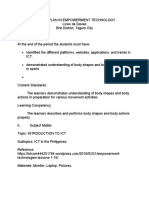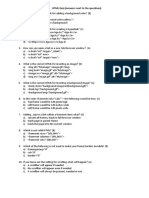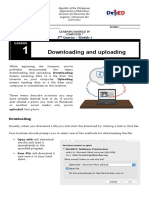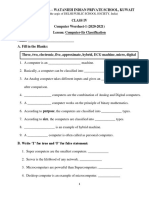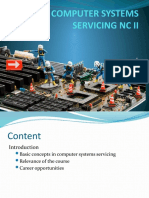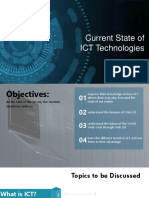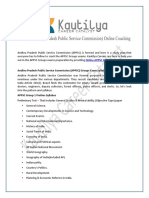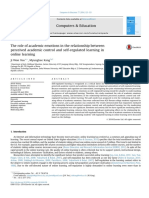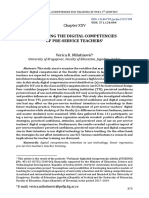100%(1)100% found this document useful (1 vote)
276 viewsTable of Specifications - E-TECH
Table of Specifications - E-TECH
Uploaded by
Rommel R Rabo1. The document is a table of specifications for an E-Tech second quarterly assessment that lists 23 learning competencies across 13 topics and how they will be assessed.
2. It outlines the number of hours spent and test items allocated to assessing lower and higher order thinking skills, including remembering, understanding, application, analysis, evaluation, and creation.
3. The competencies focus on areas like information and communication technology, online safety and ethics, online research skills, productivity tools, imaging and design, online content development, collaboration, multimedia, using ICTs for social change, and reflecting on the ICT learning process.
Copyright:
© All Rights Reserved
Available Formats
Download as DOCX, PDF, TXT or read online from Scribd
Table of Specifications - E-TECH
Table of Specifications - E-TECH
Uploaded by
Rommel R Rabo100%(1)100% found this document useful (1 vote)
276 views5 pages1. The document is a table of specifications for an E-Tech second quarterly assessment that lists 23 learning competencies across 13 topics and how they will be assessed.
2. It outlines the number of hours spent and test items allocated to assessing lower and higher order thinking skills, including remembering, understanding, application, analysis, evaluation, and creation.
3. The competencies focus on areas like information and communication technology, online safety and ethics, online research skills, productivity tools, imaging and design, online content development, collaboration, multimedia, using ICTs for social change, and reflecting on the ICT learning process.
Original Description:
Empowerment Technologies
Original Title
Table of Specifications -E-TECH
Copyright
© © All Rights Reserved
Available Formats
DOCX, PDF, TXT or read online from Scribd
Share this document
Did you find this document useful?
Is this content inappropriate?
1. The document is a table of specifications for an E-Tech second quarterly assessment that lists 23 learning competencies across 13 topics and how they will be assessed.
2. It outlines the number of hours spent and test items allocated to assessing lower and higher order thinking skills, including remembering, understanding, application, analysis, evaluation, and creation.
3. The competencies focus on areas like information and communication technology, online safety and ethics, online research skills, productivity tools, imaging and design, online content development, collaboration, multimedia, using ICTs for social change, and reflecting on the ICT learning process.
Copyright:
© All Rights Reserved
Available Formats
Download as DOCX, PDF, TXT or read online from Scribd
Download as docx, pdf, or txt
100%(1)100% found this document useful (1 vote)
276 views5 pagesTable of Specifications - E-TECH
Table of Specifications - E-TECH
Uploaded by
Rommel R Rabo1. The document is a table of specifications for an E-Tech second quarterly assessment that lists 23 learning competencies across 13 topics and how they will be assessed.
2. It outlines the number of hours spent and test items allocated to assessing lower and higher order thinking skills, including remembering, understanding, application, analysis, evaluation, and creation.
3. The competencies focus on areas like information and communication technology, online safety and ethics, online research skills, productivity tools, imaging and design, online content development, collaboration, multimedia, using ICTs for social change, and reflecting on the ICT learning process.
Copyright:
© All Rights Reserved
Available Formats
Download as DOCX, PDF, TXT or read online from Scribd
Download as docx, pdf, or txt
You are on page 1of 5
TABLE OF SPECIFICATIONS
E-Tech
Second Quarterly Assessment
No. of % of Lower Order Thinking Skills Higher Order Thinking Skills
No. of
Hours Class 60% Total Number
Learning Competencies Spent on Time on
Test 30% 10% Item Placement
of Items
Items:80
Topics Topic Remembering Understanding Application Analysis Evaluating Creating
I. INFORMATION AND
COMMUNICATION
TECHNOLOGY
1. Compare and contrast the
nuances of varied online
platforms, sites, and
content to best achieve
specific class objectives or
address situational
challenges
II. ONLINE SAFETY, SECURITY,
ETHICS, AND ETIQUETTE
2. Apply online safety,
security, ethics, and
etiquette standards and
practice in the use of ICTs
as it would relate to their
specific professional
tracks
III. CONTEXTUALIZE ONLINE
SEARCH AND RESEARCH
SKILLS
3. Use the Internet as a tool
for credible research and
information gathering to
best achieve specific class
objectives or address
situational
IV. APPLIED PRODUCTIVITY
TOOLS WITH ADVANCED
APPLICATION TECHNIQUES
4. Uses common
productivity tools
effectively by maximizing
advanced application
techniques.
5. Creates an original or
derivative ICT content to
effectively communicate
or present data or
information related to
specific professional
tracks
V. IMAGING AND DESIGN
FOR THE ONLINE
ENVIRONMENT
6. Evaluate existing websites
and online resources
based on the principles of
layout, graphic, and visual
message design
7. Use image manipulation
techniques on existing
images to change or
enhance their current
state to communicate a
message for a specific
purpose
8. Create an original or
derivative ICT content to
effectively communicate
a visual message in an
online environment
related to specific
professional tracks
VI. ONLINE PLATFORMS AS
TOOLS FOR ICT CONTENT
DEVELOPMENT
9. Evaluate existing online
creation tools, platforms
and applications in
developing ICT content
for specific professional
tracks
10. Apply web design
principles and elements
using online creation
tools, platforms, and
applications to
communicate a message
for a specific purpose in
specific professional
tracks
11. Create an original or
derivative ICT content
using online creation
tools, platforms, and
applications to effectively
communicate messages
related to specific
professional tracks
VII. COLLABORATIVE
DEVELOPMENT OF ICT
CONTENT
12. Evaluate the quality,
value, and
appropriateness of peer’s
existing or previously
developed ICT content in
relation to the theme or
intended
audience/viewer of an ICT
project
13. Share and showcase
existing or previously
developed material in the
form of a collaboratively
designed newsletter or
blog site intended for a
specific audiences or
viewer
VIII. MULTIMEDIA AND ICTs
14. Explore the principles of
interactivity and rich
content in the context of
Web 2.0 and the
participation of the user
in the online experience
IX. ICTs AS PLATFORM FOR
CHANGE
15. Share anecdotes of how
he/she has used ICTs to
be part of a social
movement, change, or
cause to illustrate aspects
of digital citizenship
X. DEVELOPING AN ICT
PROJECT FOR SOCIAL
CHANGE
16. Identify a local or regional
cause or issue for Social
Change related to specific
professional tracks that
can be addressed or
tackled using an ICT
Project for Social Changel
17. Analyse how target or
intended users and
audiences are expected
to respond to the
proposed ICT Project for
Social Change on the
basis of content, value,
and user experience
18. Integrate rich multimedia
content in design and
development to best
enhance the user
experience and deliver
content of an ICT Project
for Social Change
19. Develop a working
prototype of an ICT
Project for Social Change
XI. PUBLISHING AN ICT
PROJECT
20. Demonstrate how online
ICT Projects for Social
Change are uploaded,
manage, and promoted
for maximum audience
impact.
21. Generate a technical
report interpreting data
analytics, e.g. Google,
Facebook, or similar
traffic data on the general
aspects of search
visibility, reach, and
virality
XII. SUSTAINING AN ICT
PROJECT FOR SOCIAL
CHANGE
22. Generate a report on the
performance of their ICT
Project for Social Change
on the basis of data
gathered from available
monitoring tools and
evaluating techniques
XIII. REFLECTING ON THE ICT
LEARNING PROCESS
23. Create a reflexive piece or
output using an ICT tool,
platform, or application
of choice on the learning
experience undergone
during the semester
You might also like
- Lesson 2 BASIC of Microsoft WORD 2010Document21 pagesLesson 2 BASIC of Microsoft WORD 2010sharon may cruzNo ratings yet
- 2nd Summative-Test-NET-12-for 2nd QuaterDocument4 pages2nd Summative-Test-NET-12-for 2nd QuaterMike John Maximo100% (1)
- Word Activity 5Document2 pagesWord Activity 5api-239158883No ratings yet
- Activity Card Conditional FormattingDocument13 pagesActivity Card Conditional FormattingruffNo ratings yet
- Lesson Plan in Empowerment TechnologyDocument3 pagesLesson Plan in Empowerment TechnologyKeith Jathniel PojasNo ratings yet
- 1 PT IcfDocument10 pages1 PT IcfAmir M. VillasNo ratings yet
- LP Emp TechDocument2 pagesLP Emp TechRoderick RichardNo ratings yet
- Intro To MS Word Lesson PlanDocument4 pagesIntro To MS Word Lesson PlanJithin Clashes Zcs100% (1)
- G9ictilu Pecs-Week 1 EschnaDocument27 pagesG9ictilu Pecs-Week 1 EschnaelLiz AntalanNo ratings yet
- Computer Science Lesson Plan Week 1-PracticalDocument2 pagesComputer Science Lesson Plan Week 1-PracticalIshrat JehanNo ratings yet
- Ict Programming Week 1Document6 pagesIct Programming Week 1Ginalyn QuimsonNo ratings yet
- Quarter 1 Week 1 - Computer Programming 1Document3 pagesQuarter 1 Week 1 - Computer Programming 1Boiztupidoh Oof D'WestNo ratings yet
- EmTech Module - Q1 by Grascia - 4Document15 pagesEmTech Module - Q1 by Grascia - 4gRascia OnaNo ratings yet
- TEACHING GUIDE E-TechDocument4 pagesTEACHING GUIDE E-TechAnonymous prHphfVS7qNo ratings yet
- Empowerment-Technologies WEEK 3Document9 pagesEmpowerment-Technologies WEEK 3Arlene Diño AmuraoNo ratings yet
- Financial Statements: An OverviewDocument41 pagesFinancial Statements: An OverviewGaluh Boga Kuswara100% (1)
- Midterm - SHS Empowerment Tech G11 SY 2019 - 2020Document2 pagesMidterm - SHS Empowerment Tech G11 SY 2019 - 2020Ramir BecoyNo ratings yet
- Week 1 Day 1Document3 pagesWeek 1 Day 1Ricardo B. ViganNo ratings yet
- Learning Activity Sheet: I. Essential IdeasDocument2 pagesLearning Activity Sheet: I. Essential IdeasLorenzoNo ratings yet
- Test Questionnaires in EmpowermentDocument5 pagesTest Questionnaires in EmpowermentGerald Jhim de UbaldoNo ratings yet
- HTML Quiz (Answers Next To The Questions)Document1 pageHTML Quiz (Answers Next To The Questions)Mono100% (1)
- Yllana Bay View College, Inc.: Teaching Guide ForDocument4 pagesYllana Bay View College, Inc.: Teaching Guide Forjoel lacayNo ratings yet
- Lesson Plan Mail MergeDocument4 pagesLesson Plan Mail MergeRye EnriquezNo ratings yet
- Gr8 Photo Editing Q1M1L1Document15 pagesGr8 Photo Editing Q1M1L1zoeylaylahriveroNo ratings yet
- Lesson Plan Use Case DiagramDocument10 pagesLesson Plan Use Case DiagramSwiInoNo ratings yet
- ICF 9 Week 3-4Document7 pagesICF 9 Week 3-4Diana AdallaNo ratings yet
- Emp Tech 1ST Quarter ExamDocument3 pagesEmp Tech 1ST Quarter ExamJulian John BillonesNo ratings yet
- Quarter 1 Module 1 Week 1Document34 pagesQuarter 1 Module 1 Week 1minaNo ratings yet
- SH - Module 10 Lesson 8-LayersDocument52 pagesSH - Module 10 Lesson 8-LayersMine Cuevas Dela CruzNo ratings yet
- Etech Week 5Document7 pagesEtech Week 5Love ReynNo ratings yet
- Empowerment Technologies: Quarter 2 - Activity SheetsDocument5 pagesEmpowerment Technologies: Quarter 2 - Activity SheetsLourraine NocheNo ratings yet
- E TectDocument15 pagesE TectjulzhaideNo ratings yet
- Department of Education: Detailed Lesson PlanDocument4 pagesDepartment of Education: Detailed Lesson PlanAura LeeNo ratings yet
- Creative Tech 7 Qiii Exam 2023-2024Document3 pagesCreative Tech 7 Qiii Exam 2023-2024Florence FernandezNo ratings yet
- Empowerment Technologies Q2 Weeks 1 2Document4 pagesEmpowerment Technologies Q2 Weeks 1 2Karmi Lj P. SaraosNo ratings yet
- Microsoft Excel For Grade 8Document10 pagesMicrosoft Excel For Grade 8melvin ariasNo ratings yet
- Comp7 - Quarter 3 Module 1Document3 pagesComp7 - Quarter 3 Module 1John Mark PrestozaNo ratings yet
- Lesson Plan in Computer Studies: I. TargetsDocument3 pagesLesson Plan in Computer Studies: I. TargetsThirdy PeraltaNo ratings yet
- Icf 9 LP1Document4 pagesIcf 9 LP1Robelle DalisayNo ratings yet
- Ict Intro Complete Esson 2Document76 pagesIct Intro Complete Esson 2Cyra MadriagaNo ratings yet
- Applied Productivity Tools With Advanced Application TechniquesDocument16 pagesApplied Productivity Tools With Advanced Application TechniquesDomycelAmorGutierrezGileraNo ratings yet
- Photoshop Masking Sample Lesson PlanDocument4 pagesPhotoshop Masking Sample Lesson PlanReyn Gramatica100% (2)
- DLL Empowerment Tech Week 10Document3 pagesDLL Empowerment Tech Week 10Christopher SelebioNo ratings yet
- Worksheet 1 - Ls. Computer - Its ClassificationDocument2 pagesWorksheet 1 - Ls. Computer - Its ClassificationSivaram Kumar33% (3)
- Presentation Software:: Microsoft Powerpoint / Openoffice ImpressDocument25 pagesPresentation Software:: Microsoft Powerpoint / Openoffice ImpressRohan Delos SantosNo ratings yet
- Ani1 - MT - KeysDocument6 pagesAni1 - MT - KeysJA TamayoNo ratings yet
- Mid - Exam - in - Empowerment - Technologies Version 2Document2 pagesMid - Exam - in - Empowerment - Technologies Version 2BernardAbulocNo ratings yet
- ICF 7 TOS - 3rd QuarterDocument1 pageICF 7 TOS - 3rd QuarterSheine Nasayao MatosNo ratings yet
- Summative Test On EMPOWERMENT TECHNOLOGY Week 7Document1 pageSummative Test On EMPOWERMENT TECHNOLOGY Week 7rufino delacruz100% (1)
- Icf2 (Week 7-8)Document11 pagesIcf2 (Week 7-8)Meryl Fe P. GumeraNo ratings yet
- Computer Systems Servicing NC IiDocument32 pagesComputer Systems Servicing NC IiOwen LuzNo ratings yet
- ICF 8 THIRD GRADING Module 2Document11 pagesICF 8 THIRD GRADING Module 2Krystal AntonioNo ratings yet
- GRADES 1 To 12 Daily Lesson Log: Empowerment TechnologiesDocument4 pagesGRADES 1 To 12 Daily Lesson Log: Empowerment TechnologiesJULIETA DIWATA100% (1)
- (PPT) Lesson 1 - Current State of ICT TechnologiesDocument27 pages(PPT) Lesson 1 - Current State of ICT TechnologiesQuinn GazzinganNo ratings yet
- L6 Imaging and Design For ONLine EvironmentDocument52 pagesL6 Imaging and Design For ONLine EvironmentKilles SmileNo ratings yet
- COT 1 1st Quarter IctDocument6 pagesCOT 1 1st Quarter IctCoronia Mermaly LamsenNo ratings yet
- Yllana Bay View College, Inc.: Teaching Guide ForDocument5 pagesYllana Bay View College, Inc.: Teaching Guide ForJoel Cabusao LacayNo ratings yet
- Etech Lesson 8Document49 pagesEtech Lesson 8Mary Angel Laika BicolNo ratings yet
- Ict - Lesson 1Document74 pagesIct - Lesson 1api-335779161No ratings yet
- Subject Orientation EmTechDocument3 pagesSubject Orientation EmTechXeph AlphaNo ratings yet
- LP First Quarter Grade 7 EnglishDocument87 pagesLP First Quarter Grade 7 EnglishRommel R RaboNo ratings yet
- Types of Speech According To PurposeDocument5 pagesTypes of Speech According To PurposeRommel R Rabo100% (1)
- LP First Quarter Grade 7 EnglishDocument90 pagesLP First Quarter Grade 7 EnglishRommel R Rabo50% (2)
- Types of Speech According To PurposeDocument5 pagesTypes of Speech According To PurposeRommel R Rabo100% (1)
- Sinulog FestivalDocument7 pagesSinulog FestivalRommel R RaboNo ratings yet
- History of Ilocos Sur National High SchoolDocument2 pagesHistory of Ilocos Sur National High SchoolRommel R Rabo100% (5)
- Sentence Patterns 123Document4 pagesSentence Patterns 123Rommel R RaboNo ratings yet
- Ra7610 Child Abuse LawDocument45 pagesRa7610 Child Abuse LawRommel R Rabo100% (2)
- Stat Reviewer 2015Document3 pagesStat Reviewer 2015Rommel R RaboNo ratings yet
- Sentence Patterns 123Document4 pagesSentence Patterns 123Rommel R RaboNo ratings yet
- Color Wheel TemplateDocument1 pageColor Wheel TemplateRommel R RaboNo ratings yet
- Personal Data SheetDocument4 pagesPersonal Data SheetLeonil Estaño100% (7)
- Biag Ni Lam-AngDocument2 pagesBiag Ni Lam-AngRommel R RaboNo ratings yet
- Erf FormDocument1 pageErf FormRommel R Rabo80% (5)
- Examination PermitDocument1 pageExamination PermitRommel R Rabo100% (1)
- Montessori Child Centre Secondary School Class IxDocument3 pagesMontessori Child Centre Secondary School Class IxArjun GaurNo ratings yet
- The Effectof Mobile Learningon Students Achievementand Conversational SkillsDocument13 pagesThe Effectof Mobile Learningon Students Achievementand Conversational SkillsNORAIZA BINTI ALI HASSAN MoeNo ratings yet
- Elc 501 Article AnalysisDocument4 pagesElc 501 Article AnalysisNadhratul HusnaNo ratings yet
- Secondary Curriculm 1 - Assignment 2 Jacinta McdowallDocument28 pagesSecondary Curriculm 1 - Assignment 2 Jacinta Mcdowallapi-431932152No ratings yet
- Capstone ResearchDocument27 pagesCapstone ResearchRefugio, Quince MacamNo ratings yet
- VE023 Module 1 Course OrientationDocument15 pagesVE023 Module 1 Course OrientationCamille ArielNo ratings yet
- Gamification Elements and Their Impacts PDFDocument10 pagesGamification Elements and Their Impacts PDFAkmad Ali AbdulNo ratings yet
- User Interface Design For Effective, Engaging E-LearningDocument10 pagesUser Interface Design For Effective, Engaging E-Learningcv_VenkatNo ratings yet
- Module 6 AnswersDocument45 pagesModule 6 AnswersBernadette FloresNo ratings yet
- Theories and Research in Educational Technology and Distance Learning Instruction Through BlackboardDocument12 pagesTheories and Research in Educational Technology and Distance Learning Instruction Through BlackboardJomel AgraNo ratings yet
- Enabling and Sub Enabling OutcomesDocument86 pagesEnabling and Sub Enabling OutcomesEzekiel Ogakhan NyamuNo ratings yet
- Andhra Pradesh Public Service Commission (APPSC) Online Training - Kautilya Career CatalystDocument3 pagesAndhra Pradesh Public Service Commission (APPSC) Online Training - Kautilya Career CatalystkautilyacareersNo ratings yet
- WOTS Principle 3Document9 pagesWOTS Principle 3kenneth RixNo ratings yet
- Phil GovernmentDocument130 pagesPhil GovernmentCarlos Baul DavidNo ratings yet
- Module 1 - Special Education in The PhilippinesDocument9 pagesModule 1 - Special Education in The PhilippinesAj Comon Tabamo100% (2)
- q1 Week 2 LP Music 4Document2 pagesq1 Week 2 LP Music 4Ellyson Benito del RosarioNo ratings yet
- Ttl1 New DpeDocument483 pagesTtl1 New DpeIncense ArtisanNo ratings yet
- Answer Script For Online ICT (Student Id 1876024)Document12 pagesAnswer Script For Online ICT (Student Id 1876024)MohitNo ratings yet
- The Role of Academic Emotions in The Relationship BetweenDocument9 pagesThe Role of Academic Emotions in The Relationship Betweensonia_gonzález_54No ratings yet
- The Effectiveness of Online Joint Delivery Voucher Program On The Skills Enhancement of Gammad National High SchoolDocument43 pagesThe Effectiveness of Online Joint Delivery Voucher Program On The Skills Enhancement of Gammad National High SchoolAngelica Macasiray100% (1)
- Examining The Digital Competencies of Pre-Service TeachersDocument19 pagesExamining The Digital Competencies of Pre-Service TeachersVerica MilutinovicNo ratings yet
- IJDIWC - Volume 3, Issue 3Document132 pagesIJDIWC - Volume 3, Issue 3IJDIWCNo ratings yet
- Technology Integration and Instructional DesignDocument7 pagesTechnology Integration and Instructional DesignPedrina BrasilNo ratings yet
- Assessment 2 PdhpeDocument34 pagesAssessment 2 Pdhpeapi-379378935No ratings yet
- Topic For Midterm Oral TestDocument8 pagesTopic For Midterm Oral TestTrúc Linh TrầnNo ratings yet
- ADMS 4900D Course OutlineDocument10 pagesADMS 4900D Course OutlinejorNo ratings yet
- Learning Action Cell ReflectionDocument4 pagesLearning Action Cell ReflectionKrisha MaataNo ratings yet
- Disciplined Agile Senior Scrum Master Certification - PMIDocument4 pagesDisciplined Agile Senior Scrum Master Certification - PMIMehmet Levent DEMİRNo ratings yet
- Grant E. 2016 - Designing Carceral EnvirDocument144 pagesGrant E. 2016 - Designing Carceral EnvirSzucsákiMelinda100% (1)
- For and Aganist EssayDocument1 pageFor and Aganist EssayYağmur Melis UzunNo ratings yet




